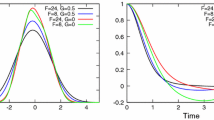Abstract
Correlation functions for the stochastic description of the single mode laser are investigated using the simple approximation method presented in part I[1]. The application of the mean relaxation time approximation to stochastic systems with state spaces of dimensiond>1 is thereby demonstrated. Our approach yields results which are indistinguishable from the actual lineshape. Hence, they constitute a slight improvement over the results of Risken and co-workers, where these results are based on an analysis of the lowest eigenvalue of the stochastic operator.
Similar content being viewed by others
References
Nadler, W., Schulten, K.: Z. Phys. B-Condensed Matter59, 53 (1985); part I of the present series
Schulten, K., Brünger, A., Nadler, W., Schulten, Z.: In: Synergetics-from microscopic to macroscopic order. Frehland, E. (ed.), p. 80. Berlin, Heidelberg, New York: Springer 1984
Brünger, A., Peters, R., Schulten, K.: J. Chem. Phys.82, 2147 (1985)
Nadler, W., Marcus, R.A.: J. Chem. Phys.86, 3906 (1987)
Nadler, W., Schulten, K.: Phys. Rev. Lett.51, 1712 (1983)
Nadler, W., Schulten, K.: Proc. Natl. Acad. Sci. USA81, 5719 (1984)
Nadler, W., Schulten, K.: J. Chem. Phys.84, 4015 (1986)
Zwanzig, R.: In: Lectures in theoretical physics, Vol. 3. Brittin, W., Dunham, L. (eds.), p. 135 New York: Wiley 1961
Mori, H.: Prog. Phys.34, 399 (1965)
Grossmann, S.: Phys. Rev. A17, 1123 (1978)
Risken, H.: Z. Phys.191, 302 (1966)
Risken, H., Vollmer, H.D.: Z. Phys.201, 323 (1967)
Seybold, K., Risken, H.: Z. Phys.267, 323 (1974)
Risken, H.: The Fokker-Planck Equation. Berlin, Heidelberg: Springer 1984
An appealing intuitive picture of this process is given in: Mooradian, A.: Phys. Today38(5), 43 (May 1985)
Arecchi, F.T., Giglio, M., Sona, A.: Phys. Lett.25A, 341 (1967)
Gerhardt, H., Welling, H., Güttner, A.: Z. Phys.253, 113 (1972)
Nadler, W., Schulten, K.: J. Chem. Phys.82, 151 (1985)
Press, W.H., Flannery, B.P., Teukolsky S.A., Vetterling, W.T.: Numerical recipes. Cambridge: Cambridge University Press 1986
Schenzle, A., Brand, H.: Phys. Rev. A20, 1628 (1979)
Fujisaka, H., Grossmann, S.: Z. Phys. B-Condensed Matter43, 69 (1981)
Jung, P., Risken, H.: Z. Phys. B-Condensed Matter59, 469 (1985)
Jung, P., Leiber, Th., Risken, H.: Z. Phys. B-Condensed Matter66, 397 (1987)
Ziegler, K., Horner, H.: Z. Phys. B-Condensed Matter37, 339 (1980); we note that this paper also discusses the problems arising from an inappropriate renormalization of the perturbation expansion
For a somewhat different approach see Richter P.H., Grossmann, S.: Z. Phys248, 244 (1971); one result of this work is corrected in: ibid.255, 59 (1972)
Although the drift forces in (3.1) cannot be derived anymore from the potential that governs the stationary distribution, detailed balance still holds for this model. see [13]
We note that, since the correlation functionECE(t) is real, its generalized moments (2.11) are also real, although the operator (3.2) has complex eigenvalues. Therefore, the MRTA has a solely relaxational behavior
That the calculation of generalized moments in manifestly higher-dimensional systems is numerically feasible was demonstrated in [7] using sparse matrix techniques. Limitations arise only through the size of the actually available computer memory, which is steadily increasing in recent years
Shenoy, S.R., Agarwal, G.S.: Phys. Rev. A29, 1315 (1984)
Wang, X.W., Lin, D.L., Hioe, F.T.: Phys. Rev. A34, 1251 (1986)
Lett, P.: Phys. Rev. A34, 2044 (1986)
Grossmann, S., Krauth, W.: Phys. Rev. A35, 2523 (1987)
Krauth, W., Grossmann, S.: Phys. Rev. A35, 4192 (1987)
Dixit, S.N., Sahni, P.S.: Phys. Rev. Lett.50, 1273 (1983)
Leiber, Th., Jung, P., Risken, H.: Z. Phys. B-Condensed Matter68, 123 (1987)
Leiber, Th., Marchesoni, F., Risken, H.: Phys. Rev. Lett.59, 1381 (1987)
Doering, C.R., Hagan, P.S., Levermore, C.D.: Phys. Rev. Lett.59, 2129 (1987)
Jung, P., Hänggi, P.: Phys. Rev. Lett.61, 11 (1988)
Author information
Authors and Affiliations
Rights and permissions
About this article
Cite this article
Nadler, W., Schulten, K. Mean relaxation time approximation for dynamical correlation functions in stochastic systems near instabilities. Z. Physik B - Condensed Matter 72, 535–543 (1988). https://doi.org/10.1007/BF01314535
Received:
Revised:
Issue Date:
DOI: https://doi.org/10.1007/BF01314535



